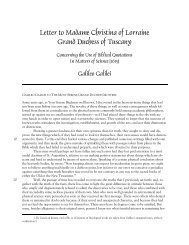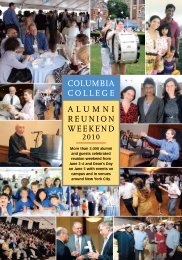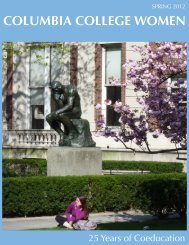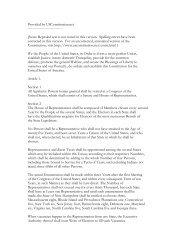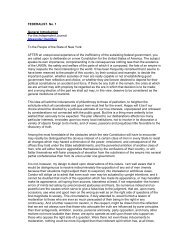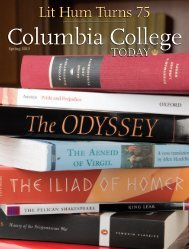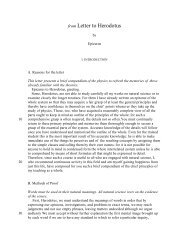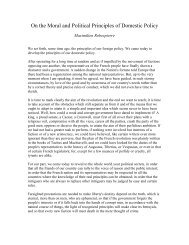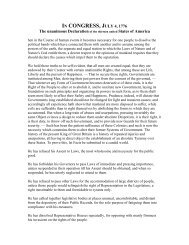Japan Storm - Columbia College - Columbia University
Japan Storm - Columbia College - Columbia University
Japan Storm - Columbia College - Columbia University
You also want an ePaper? Increase the reach of your titles
YUMPU automatically turns print PDFs into web optimized ePapers that Google loves.
COLUMBIA COLLEGE TODAY CLASS NOTES<br />
has died. His obituary will be published<br />
in a future issue of CCT.<br />
Please note that my class email<br />
list does not include everyone, and<br />
some addresses are invalid. If you<br />
do not receive email correspondence<br />
from me, chances are you fit<br />
into one of those two categories. If<br />
you want to be included in class<br />
emails, please send me your email<br />
address; only with your permission<br />
will I share it with <strong>Columbia</strong>.<br />
Or, you may send it to CCT at<br />
cct@columbia.edu (subject line:<br />
“CC’59 email”), and the CCT staff<br />
will update your record and then<br />
share it with me, but again, they will<br />
share only with your permission.<br />
60<br />
Robert A. Machleder<br />
69-37 Fleet St.<br />
Forest Hills, NY 11375<br />
rmachleder@aol.com<br />
Terrence McNally’s play Master<br />
Class had a Broadway revival this<br />
summer starring Tyne Daly as<br />
Maria Callas. Considered by critics<br />
to be Terrence’s finest work, it was<br />
first presented in November 1995<br />
and won the Drama Desk Award<br />
for Outstanding New Play and<br />
the 1996 Tony Award for Best Play.<br />
Two members of the original cast,<br />
Zoe Caldwell (in the role of Callas)<br />
and Audra McDonald (in the<br />
role of a student), won 1996 Tony<br />
awards for acting. The play, based<br />
on a series of master classes held<br />
by Callas at the Juilliard School in<br />
the early 1970s after her voice had<br />
faded and her career had come to<br />
an end, integrates opera selections,<br />
the diva’s penetrating dissection<br />
and reshaping of the performances<br />
of three aspiring opera singers, and<br />
lapses into reflections on her own<br />
rise, fueled by her intense ambition,<br />
from a performer criticized for<br />
being overweight and unattractive<br />
at the beginning of her career to the<br />
triumphant pinnacle of achievement,<br />
acclaimed as La Divina, the<br />
most brilliant and glamorous sop-<br />
rano of an era. Callas’ desires,<br />
insecurities and vulnerabilities, a<br />
burning hatred of her rivals and<br />
of a press that derided her early<br />
performances, and an exposition of<br />
the commitment and sacrifices that<br />
are the price of achieving excellence,<br />
are exposed in impassioned and ofttimes<br />
humorous monologues.<br />
Terrence fell in love with Callas’<br />
voice when he was a youth<br />
growing up in Corpus Christi,<br />
Texas; he found himself moved by<br />
its haunting and unique beauty.<br />
At a time when he was teaching<br />
playwriting at Juilliard he stopped<br />
in to observe a master class being<br />
conducted by Leontyne Price,<br />
and the idea formed from which<br />
Master Class evolved. Although<br />
recordings existed of Callas’ master<br />
classes, Terrence never listened<br />
to them. “The play,” he said, “is<br />
my projection of Callas’ life, not a<br />
documentary.”<br />
Doug Morris assumed the post<br />
of chief executive of Sony Music<br />
Entertainment in July. After serving<br />
as chief executive and then as chairman<br />
of Universal Music Group,<br />
the label he helped found in 1995,<br />
Doug was granted an early release<br />
from his contract at Universal to<br />
join its biggest rival. Doug has been<br />
regarded as a skilled manager of executives<br />
as well as an artistic talent.<br />
In his tenure at Universal its roster<br />
of artists has included U2, Eminem,<br />
Jay-Z, Kanye West, Amy Winehouse,<br />
Lady Gaga, Justin Bieber<br />
and Rihanna; it has commanded<br />
the industry’s largest market share,<br />
with about 31 percent of sales, and<br />
generated revenues exceeding $6<br />
billion a year. The eyes of the industry<br />
are on Doug to see whether he<br />
can achieve the same success for the<br />
Sony label.<br />
Hillel Halkin, author, scholar<br />
and translator, appears as one of<br />
several distinguished talking heads<br />
in a critically acclaimed documentary<br />
released this summer, Sholem<br />
Aleichem: Laughing in the Darkness.<br />
The documentary examines the<br />
life of the humorist and storyteller<br />
(born Solomon Rabinovich) using<br />
archival material and, as a Los<br />
Angeles Times film critic put it, “perceptive<br />
interviews with some of the<br />
best thinkers in the Yiddish world,<br />
including academics Dan Miron,<br />
David Roskies and Ruth Wisse;<br />
translator Hillel Halkin; the National<br />
Yiddish Book Center’s Aaron<br />
Lansky; and author Bel Kaufman,<br />
Sholem Aleichem’s 100-year-old<br />
granddaughter.” In the words of<br />
another critic: “Hillel Halkin proves<br />
to be the movie’s sharpest, funniest,<br />
most Sholem Aleichem-like commentator.”<br />
A young man’s gaze moves in<br />
an arc, west, south, east, over the<br />
Hudson River, the George Washington<br />
Bridge, on to the spires of<br />
Manhattan, then the Bronx with its<br />
bank of lights from Yankee Stadium<br />
that illuminate the field as the night<br />
game progresses; he scans the sky<br />
from the terrace of his new apartment<br />
high above the palisades of<br />
Spuyten Duyvil. His knowledge of<br />
the stars and nebulas, informed by<br />
visits to the Hayden Planetarium<br />
and overnight hikes with the Boy<br />
Scouts as a youngster, is limited.<br />
Now, an opportunity to expand<br />
WINTER 2011–12<br />
67<br />
that knowledge. He assembles<br />
the telescope that arrives in a kit<br />
and affixes it to its wooden tripod.<br />
Sky-map in hand, he focuses on an<br />
object in space. The object appears,<br />
a pinpoint of light in the eyepiece.<br />
Adjust the lens to draw it closer ...<br />
but it’s gone. Focus again, sight the<br />
object ... the waft of the gentlest of<br />
breezes seems magnified through<br />
the lens to the intensity of a gale,<br />
and multiple images in the eyepiece<br />
are in violent motion; perhaps it is<br />
only that single point of light, but<br />
it refuses to hold still. The necklace<br />
lights of the bridge, the beacon<br />
of the Empire State Building, the<br />
brilliant nightscape of Manhattan<br />
and the glow from the stadium all<br />
compete with and overwhelm the<br />
sparkling specs in the firmament. A<br />
succession of futile efforts and the<br />
telescope is retired to a place that<br />
time has forgotten.<br />
The man, now much closer to<br />
the end of his string than its beginning,<br />
smiles wistfully at this mem-<br />
Hillel Halkin ’60 appears in the critically acclaimed<br />
documentary Sholem Aleichem: Laughing in the<br />
Darkness.<br />
ory as he reads Tom Hamilton’s<br />
latest book, Useful Star Names: With<br />
Nebulas And Other Celestial Features.<br />
Tom, a professor of astronomy for<br />
32 years, now retired, says that his<br />
students always preferred to learn<br />
a star by its name, rather than its<br />
catalog number. “Teegarden’s Star<br />
is so much nicer sounding than SO<br />
0255790.5.” The book is a wonderful,<br />
useful guide for any stargazer;<br />
a compendium in four parts, listing,<br />
alphabetically, the 88 constellations,<br />
providing the names of the<br />
stars, nebulas and galaxies within<br />
each, their brightness and their<br />
location according to the two coordinates<br />
of Declination and Right<br />
Ascension. This old man enjoyed<br />
perusing the lists and finding the<br />
brightest star, Sirius, which has a<br />
-1.46 magnitude and is one of the<br />
closest stars to us at a distance of<br />
8.6 light years; that it is in the constellation<br />
Canis Major (one of the<br />
smallest constellations — 71st of<br />
the 88); and, that its Declination is<br />
-16^42’58” and its Right Ascension<br />
is ... but I’ll let you have the fun<br />
of finding that out in Tom’s book.<br />
Tom advises that he is now at work<br />
on his next astronomy book. And<br />
this old man, inspired by Useful<br />
Star Names, is contemplating the<br />
purchase of another telescope.<br />
Ivan Koota sends his regards to<br />
all and advises that his work was<br />
exhibited in several group shows<br />
in 2011: The Albany Institute of Art<br />
Regional Exhibition; the Roberson<br />
Regional Art Exhibition at the Rob-<br />
erson Museum in Binghamton,<br />
N.Y.; the Albany Center Gallery Regional<br />
Competition; the Woodstock<br />
Artists Association and Museum<br />
in Woodstock, N.Y.; and the Van<br />
Brunt Projects in Beacon, N.Y. Ivan<br />
advised some months ago that he<br />
was working in collaboration with<br />
published author Lenny Mintz on<br />
a book to include Ivan’s Brooklyn<br />
paintings and his collaborator’s<br />
Brooklyn stories. Check Ivan’s website<br />
(brooklynplaces.com) for more<br />
information as to its availability.<br />
A somewhat belated advisory<br />
to classmates from Nathan Gross<br />
that the souvenir compact disc of<br />
the “Sweetest Sixty Suite,” received<br />
after Nathan’s cabaret at our 50th<br />
reunion, will indeed play on a<br />
computer even if a regular CD<br />
player refuses it. Nathan spent his<br />
summer, as he has through the<br />
years, “teaching French in Paris<br />
for the <strong>University</strong> of San Diego Institute<br />
on International and Comparative<br />
Law. My students in the<br />
past several years have included,<br />
beyond the usual Californians and<br />
Midwesterners, young lawyers<br />
from Russia, Italy, Mexico, Spain<br />
— from all over the map. They<br />
are culturally savvier than our<br />
homegrown varieties; they enliven<br />
the class atmosphere and keep<br />
me returning. I also carry out the<br />
duties of a guide — my training as<br />
a 17th-century specialist comes in<br />
handy during walks, especially in<br />
the Marais neighborhood where<br />
the institute is located. I conduct<br />
a favorites tour of the Louvre in<br />
English, encouraging discussion as<br />
we stand before objects of special<br />
interest to lawyers — the Code of<br />
Hammurabi, for example — and<br />
paintings that have grown on me<br />
over some 40-very-odd years.<br />
Humanities A comes in handy as<br />
we examine a Rubens based on<br />
Herodotus and one of Rembrandt’s<br />
Bathshebas. (We used to read<br />
extensively in the Old Testament<br />
in my own Humanities sections,<br />
including the Books of Samuel as<br />
an example of historiography.) I<br />
am constantly reminded of how<br />
Philip Gould taught how to look<br />
and to see in that one class in Art<br />
Humanities I took. We also visit<br />
Reims where somehow (hardly<br />
somehow, of course: it all comes<br />
from listening closely to the guides<br />
in many past visits, and, mostly,<br />
from my good friend the Internet)<br />
I have become an expert, amateur<br />
but knowledgeable nonetheless,<br />
on the history and sculptural<br />
programs of the gothic cathedral<br />
and the basilica of Saint Rémi. It<br />
seems a far cry from Molière and<br />
Racine, but in essence observing<br />
and asking the right questions is<br />
the practice I learned in college, at<br />
graduate school and while leading




